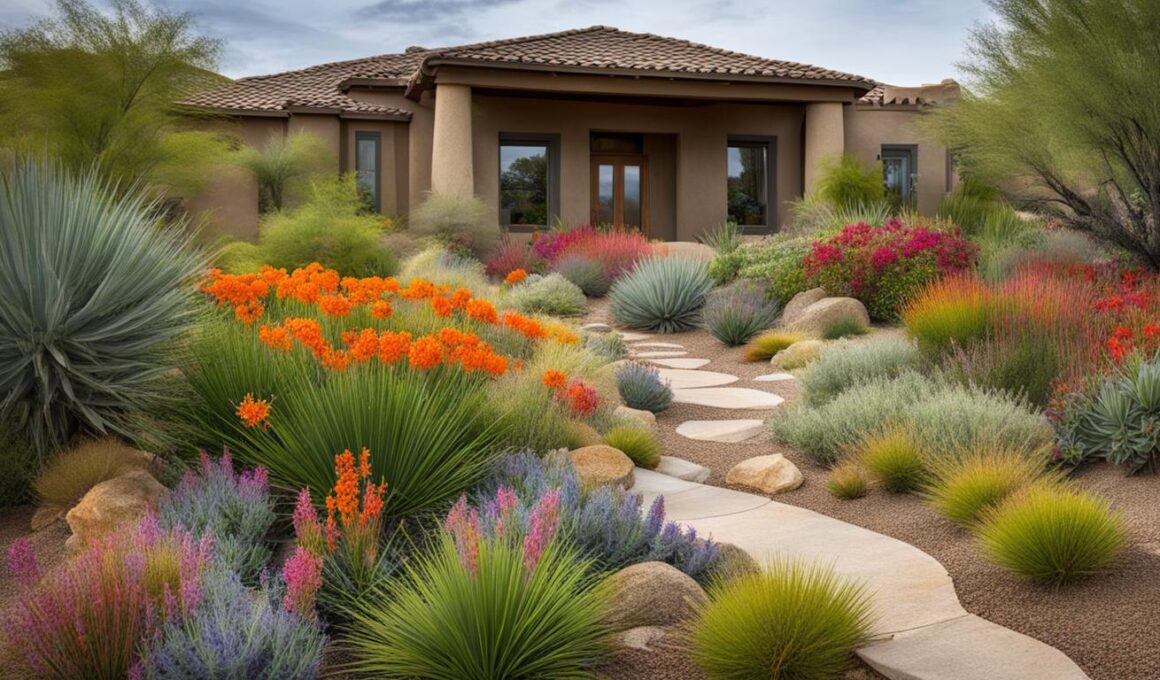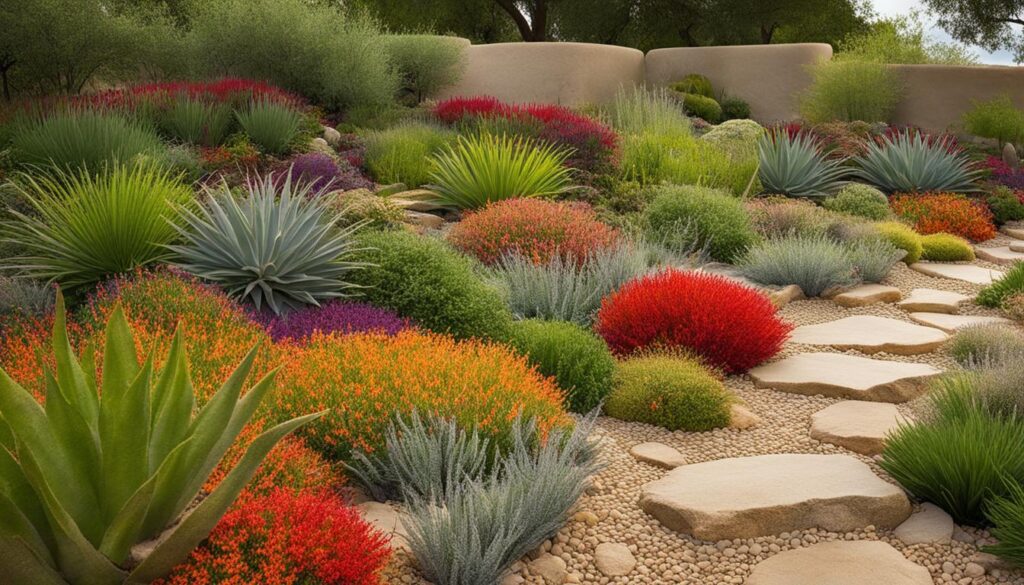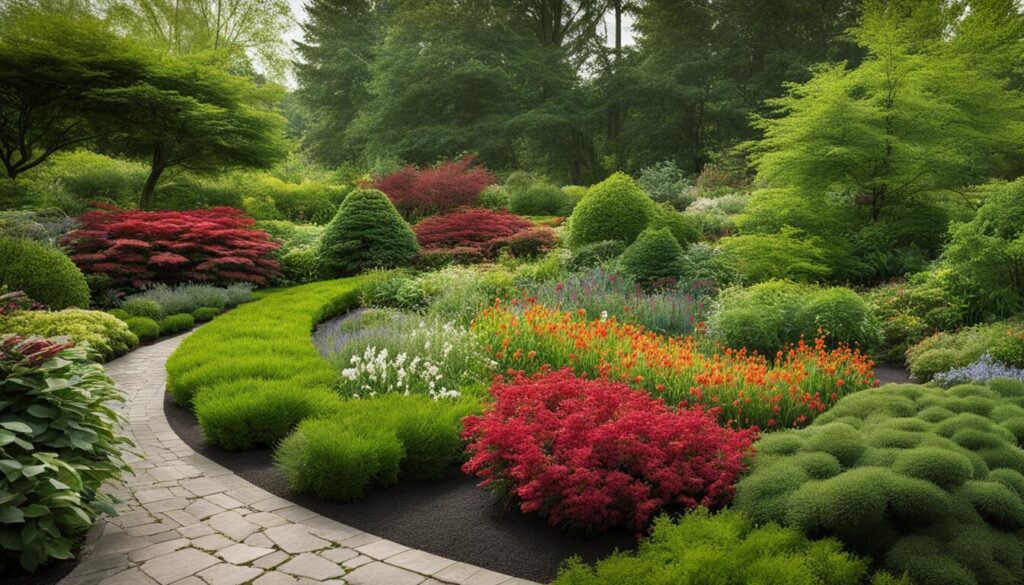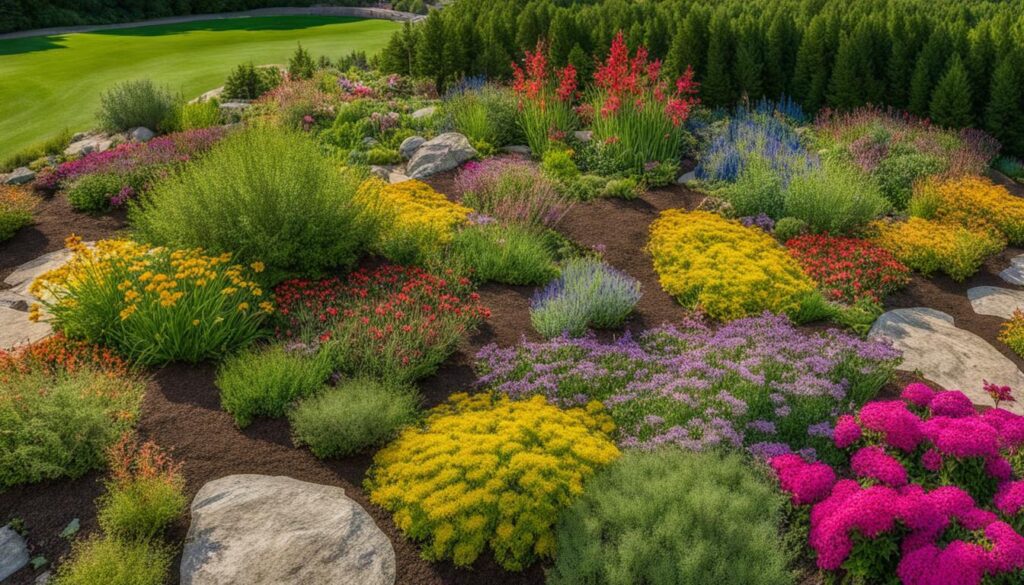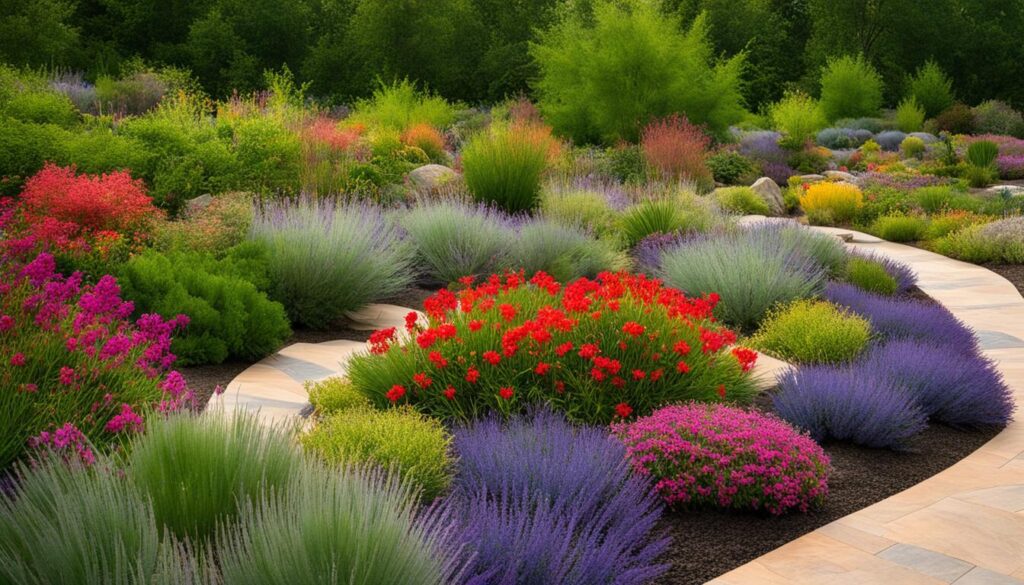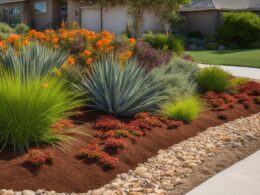Xeriscape gardens have become increasingly popular in the United States as a low-water gardening technique. Contrary to common misconceptions, these gardens don’t have to be boring or limited to cacti and succulents. In fact, there is a wide variety of native flowering plants that can thrive in xeriscape gardens, adding beauty and reducing the need for excessive irrigation.
Key Takeaways:
- Native flowering plants offer sustainable options for xeriscape gardens.
- These plants can reduce water usage in your garden.
- Xeriscape gardens can be visually appealing and support local ecosystems.
- Incorporating ground covers, short plants, and native shade gardens can add diversity to your xeriscape design.
- Proper planning, planting, and maintenance are essential for successful xeriscape gardens.
What is Xeriscaping?
Xeriscaping is a landscaping approach that aims to reduce the use of water by using plants and techniques that require minimal irrigation. It is often associated with dry and arid landscapes, but in reality, xeriscaping can create lush and vibrant gardens. By implementing the principles of xeriscaping, you can create a beautiful and sustainable landscape that is both water-wise and visually appealing.
The key principles of xeriscaping include:
- Planning in advance: Design your landscape to maximize water efficiency and choose plants that are well-suited for your local climate.
- Limiting turfgrass: Reduce or eliminate water-intensive turfgrass areas and replace them with low-water alternatives.
- Choosing plants with lower water needs: Select native or drought-tolerant plants that can thrive with minimal watering.
- Grouping plants with similar watering requirements: Arrange plants with similar water needs together to make irrigation more efficient.
- Using targeted irrigation systems: Install drip irrigation or soaker hoses to deliver water directly to the roots of plants, minimizing evaporation and runoff.
- Mulching to reduce evaporation: Apply a layer of organic mulch around plants to conserve moisture, suppress weeds, and regulate soil temperature.
- Maintaining plants to prevent excessive water needs: Regularly monitor and care for your plants to ensure they are healthy and not requiring unnecessary watering.
By following these principles, you can create a low-water gardening oasis that not only reduces your water usage but also contributes to a more sustainable and environmentally friendly landscape.
Benefits of Xeriscaping
Xeriscaping can offer numerous benefits, including:
- Water conservation: Xeriscaping can significantly reduce your water consumption, helping to conserve this precious resource.
- Cost savings: By minimizing the need for irrigation, xeriscaping can lead to lower water bills and reduced maintenance costs.
- Drought tolerance: Xeriscape gardens are designed to withstand drought conditions, making them more resilient to water shortages.
- Environmental sustainability: By using native and drought-tolerant plants, xeriscaping promotes biodiversity and supports local ecosystems.
- Increased property value: Well-designed xeriscape gardens can enhance the aesthetic appeal of your property and potentially increase its value.
With its focus on water-wise gardening practices, xeriscaping is an excellent choice for homeowners who want to create beautiful, sustainable landscapes while minimizing their impact on the environment.
| Principles of Xeriscaping | Benefits |
|---|---|
| Planning in advance | Water conservation |
| Limiting turfgrass | Cost savings |
| Choosing plants with lower water needs | Drought tolerance |
| Grouping plants with similar watering requirements | Environmental sustainability |
| Using targeted irrigation systems | Increased property value |
| Mulching to reduce evaporation | |
| Maintaining plants to prevent excessive water needs |
Ground Covers for Xeriscape Gardens
When it comes to creating a beautiful and water-efficient xeriscape garden, ground covers are an excellent choice. These low-growing plants not only provide visual interest but also help to cover large areas with minimal water requirements. Here are some recommended ground covers for your xeriscape garden:
Sedum Rubrotinctum (Jelly Bean Plant)
The Sedum Rubrotinctum, also known as the Jelly Bean Plant, is a drought-tolerant ground cover that features succulent leaves in vibrant shades of green and red. With its low water needs and ability to spread quickly, it’s an ideal choice for xeriscape gardens.
Pachysandra Procumbens (Allegheny Spurge)
The Pachysandra Procumbens, or Allegheny Spurge, is a native ground cover that thrives in shady areas. It features beautiful green foliage and delicate white flowers that bloom in the spring, adding a touch of elegance to your xeriscape garden.
Ophiopogon Japonicus (Dwarf Lilyturf)
The Ophiopogon Japonicus, also known as Dwarf Lilyturf, is a versatile ground cover that is both drought-tolerant and deer-resistant. Its compact size and dark green foliage make it a perfect choice for borders, walkways, or as a filler between taller plants in your xeriscape garden.
Ophiopogon Planiscapus (Black Mondo Grass)
The Ophiopogon Planiscapus, or Black Mondo Grass, is a unique ground cover that adds a touch of drama to any xeriscape garden. Its dark purple-black foliage creates a striking contrast against other plants, and its low water needs make it an excellent choice for water-wise landscaping.
By incorporating these ground covers into your xeriscape garden, you can create a visually appealing and sustainable landscape that requires minimal watering. These plants not only reduce water usage but also add texture, color, and interest to your outdoor space. Choose the ground covers that best suit your climate and design preferences, and watch your xeriscape garden thrive.
Short Plants for Xeriscape Gardens
When designing a xeriscape garden, incorporating short plants is a smart choice to add visual interest and beauty to your landscape. These plants not only provide texture and color but also require minimal water, making them ideal for drought-tolerant gardens. Here are some recommended short plants that will thrive in your xeriscape garden:
Aloe Aristata (Lace Aloe)
This stunning succulent features rosettes of fleshy, spiky leaves with white speckles. It produces vibrant coral-red flowers during the summer months, attracting pollinators to your garden. The Lace Aloe is drought-tolerant and requires well-drained soil.
Erigeron Karvinskianus (Santa Barbara Daisy)
The Santa Barbara Daisy is a charming perennial that spreads quickly to form a lush ground cover. It boasts delicate, daisy-like flowers in shades of white and pink, adding a touch of whimsy to your garden. This plant is drought-tolerant and thrives in full sun or partial shade.
Euphorbia Myrsinites (Myrtle Spurge)
The Myrtle Spurge is a low-growing succulent with striking blue-green foliage that contrasts beautifully with its yellow flowers. This plant is incredibly resilient and can tolerate drought, heat, and poor soil conditions. However, take caution as it contains a sap that can cause skin irritation.
Sedum Kamtschaticum (Russian Stonecrop)
The Russian Stonecrop is a hardy perennial that forms a dense mat of succulent foliage. It produces clusters of bright yellow flowers that attract butterflies and bees. This plant is drought-tolerant and can thrive in rocky or sandy soil. It’s an excellent choice for rock gardens or border plantings.
Callirhoe Involucrata (Purple Poppy-Mallow)
The Purple Poppy-Mallow is a beautiful native wildflower that features deep purple flowers with contrasting white centers. This plant has a trailing growth habit and can quickly cover large areas, making it perfect for ground covers or cascading over walls. It is drought-tolerant and prefers full sun to partial shade.
Formal Native Shade Gardens for Xeriscape Landscaping
Creating a formal native shade garden in your xeriscape landscape can add a touch of elegance and tranquility to your outdoor space. These gardens utilize shade-tolerant native plants that not only reduce the need for excessive watering but also thrive in areas with limited sunlight. By incorporating these plants, you can create a visually stunning and sustainable garden that is both low-maintenance and environmentally friendly.
When designing your formal native shade garden, consider incorporating plants such as the Aloe Brevifolia (Crocodile Aloe), Salvia Sonomensis (Sonoma Sage), Salvia Chamaedryoides (Germander Sage), Oxalis Triangularis (False Shamrock), and Rohdea Japonica (Japanese Sacred Lily). These plants are well-suited for shady areas and can add a burst of color and texture to your garden.
“A formal native shade garden can be a peaceful retreat within your xeriscape landscape, offering a cool respite from the sun while providing habitat for native wildlife.”
To create a visually appealing layout, consider using formal design elements such as symmetrical plantings, neatly trimmed hedges, and structured pathways. This will give your garden a polished and sophisticated look. Additionally, adding features like seating areas or water features can enhance the overall ambiance of your space.
Table: Recommended Plants for Formal Native Shade Gardens
| Plant Name | Common Name | Water Requirement | Sun Exposure | Special Considerations |
|---|---|---|---|---|
| Aloe Brevifolia | Crocodile Aloe | Low | Partial Shade | Drought-tolerant |
| Salvia Sonomensis | Sonoma Sage | Low | Partial Shade | Attracts pollinators |
| Salvia Chamaedryoides | Germander Sage | Low | Partial Shade | Drought-tolerant, deer-resistant |
| Oxalis Triangularis | False Shamrock | Low | Partial Shade | Thrives in acidic soils |
| Rohdea Japonica | Japanese Sacred Lily | Low | Partial Shade | Evergreen foliage |
When maintaining your formal native shade garden, be sure to provide proper watering and mulching to retain moisture and suppress weed growth. Regularly monitor the health of your plants and remove any diseased or dying foliage. Consider incorporating organic fertilizers to keep your plants thriving.
A formal native shade garden can be a peaceful retreat within your xeriscape landscape, offering a cool respite from the sun while providing habitat for native wildlife. With careful planning and attention to detail, you can create a stunning garden that showcases the beauty of native shade plants and enhances the overall aesthetic of your outdoor space.
Establishing Native Gardens with Plants or Seeds
When it comes to creating a native garden, you have two options: planting native plants or sowing native seeds. Both methods have their advantages and can result in beautiful and sustainable landscapes. Let’s explore how you can establish your own native garden using either plants or seeds.
Planting Native Plants
Planting native plants from containers is a popular choice for establishing a native garden. This method allows for quick establishment and ensures that the plants will reach maturity within a few years. Before planting, it’s important to prepare the soil by removing any existing grass and weeds. This will create a clean and fertile environment for the native plants to thrive.
When selecting native plants, choose species that are well-suited to your specific climate and soil conditions. Native plants are adapted to local conditions, making them more resilient and better able to withstand drought and pests. Be sure to provide proper spacing between plants to allow for healthy growth and airflow.
After planting, regular watering is essential for the initial establishment of the native plants. Once they are established, they will require less water and maintenance compared to non-native species. Monitor the health of the plants and provide additional water during periods of drought or extreme heat.
Sowing Native Seeds
If you prefer a more hands-on approach, you can establish a native garden by sowing native seeds. This method requires more time and patience, but it can be rewarding to see your garden grow from tiny seeds.
Before sowing the seeds, prepare the site by eliminating existing vegetation and creating a suitable seedbed. This can be done by removing grass and weeds, raking the soil to create a smooth surface, and incorporating organic matter if needed.
Sowing native seeds should be done during the dormant season, which is typically in fall or early spring. Follow the instructions provided with the seeds for the best results. Lightly cover the seeds with a thin layer of soil and water gently to ensure good seed-to-soil contact.
As the seeds germinate and the plants grow, be mindful of weed control. Remove any weeds that may compete with the native seedlings for nutrients and water. Mulching the area can also help suppress weed growth and conserve moisture in the soil.
With proper care, both planting native plants and sowing native seeds can result in thriving and sustainable native gardens. Whether you choose one method or a combination of both, you’ll be creating a habitat that supports local biodiversity and conserves water resources.
Maintaining Native Landscapes
Maintaining native landscapes is crucial for the long-term health and beauty of your xeriscape garden. By following some simple practices, you can ensure that your plants thrive while minimizing water usage and keeping weeds under control.
Mulching for Moisture Conservation
One of the key steps in maintaining native landscapes is mulching. Applying a layer of organic mulch helps conserve moisture in the soil, reducing the need for frequent watering. Additionally, mulch acts as a barrier against weed growth, keeping your garden beds tidy and easy to maintain.
When choosing a mulch, opt for organic materials such as compost, shredded leaves, or pine needles. These materials not only help retain moisture but also improve the soil structure over time as they break down. Apply a layer of mulch around your native plants, leaving a small space around the stems to prevent rotting.
Effective Weed Control
Weed control is essential to maintain the health and appearance of your native landscape. Before planting your garden, remove any existing weeds and minimize the presence of weed seeds in the soil. This initial work will save you time and effort in the long run.
Regularly inspect your garden for any weed growth and promptly remove them. It’s best to pull weeds by hand, ensuring that you remove the entire root system to prevent regrowth. Be careful not to disturb the roots of your native plants when weeding.
By implementing these maintenance practices, you can enjoy a vibrant and sustainable native landscape. Mulching and weed control will help your xeriscape garden thrive while minimizing water consumption and keeping your plants healthy and weed-free.
What Are the Best Native Flowering Plants for Xeriscape Gardens in the US?
When creating a xeriscape garden in the US, it’s important to choose native xeriscape plant selection tips to ensure they thrive in the local climate. Some great options for flowering plants include Black-eyed Susan, Purple Coneflower, and Texas Sage, all of which are well-suited for dry, arid conditions.
Conclusion
Native flowering plants offer a diverse range of options for creating beautiful and sustainable xeriscape gardens. By incorporating these plants, you can reduce your water usage, create visually appealing landscapes, and support local ecosystems. Whether you choose ground covers, short plants, or native shade garden designs, xeriscape gardens can thrive with low-water and low-maintenance plant choices.
With proper planning, planting, and maintenance, you can transform your yard into a drought-tolerant paradise filled with native beauty. Native flowering plants not only add color and texture to your garden but also attract pollinators, enhancing the biodiversity of your outdoor space. As you enjoy the vibrant blooms and lush foliage, you’ll also be contributing to the conservation of local plant species.
So, embrace xeriscape gardening and make the most of native flowering plants. Create a sustainable landscape that requires less water and maintenance, and enjoy the beauty that these drought-tolerant plants bring to your surroundings. With their resilience and adaptability, native flowering plants are the perfect addition to any xeriscape garden, providing both aesthetic appeal and environmental benefits.





